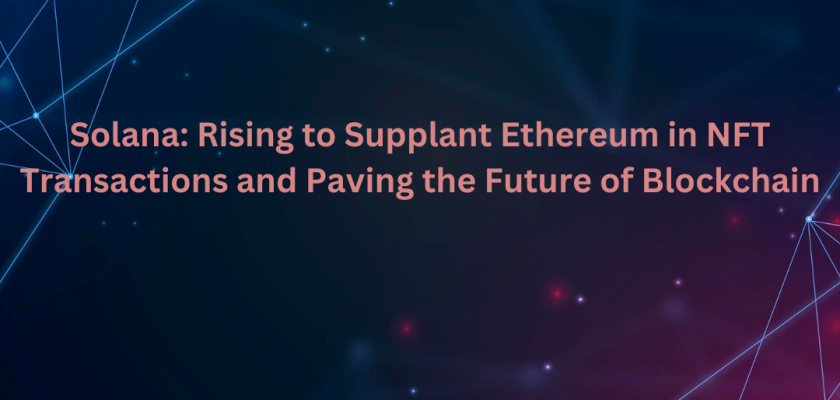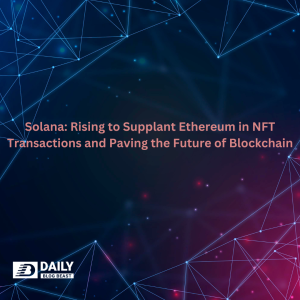Introduction
The blockchain landscape has undergone significant evolution since the inception of cryptocurrencies. Ethereum, the pioneering smart contract platform, has played a pivotal role in shaping decentralized applications (dApps) and the Non-Fungible Token (NFT) market. However, as technology continues to advance, new challengers are emerging. Solana, a high-performance blockchain, has risen to prominence, positioning itself as a serious contender to dethrone Ethereum in NFT transactions and reshape the future of the blockchain ecosystem.
The Emergence of Solana
1.1 The Scalability Challenge of Ethereum As the popularity of decentralized applications and NFTs surged, Ethereum faced a critical problem – scalability. The platform’s limited throughput and high gas fees hindered its ability to support mass adoption. As demand increased, the network congestion worsened, causing slow transaction processing and frustrating user experiences.
1.2 Enter Solana – A Breakthrough in Scalability Solana, founded in 2017 by Anatoly Yakovenko, emerged as a promising alternative to Ethereum’s scalability woes. Built on a unique architecture leveraging Proof of History (PoH) and Tower BFT (Byzantine Fault Tolerance), Solana achieved incredible throughput and low latency. The platform’s scalable nature allowed it to process thousands of transactions per second, making it a compelling choice for dApps and NFT projects seeking high-speed performance.
Solana’s Rise in NFT Transactions
2.1 NFT Boom and Ethereum’s Struggles The NFT craze that swept the world highlighted the limitations of Ethereum. As artists, creators, and collectors flocked to mint, trade, and purchase NFTs, the congestion on Ethereum’s network became even more evident. High gas fees and slow confirmation times led to frustration, prompting many to seek alternative platforms.
2.2 Solana’s NFT-Friendly Environment Solana capitalized on Ethereum’s limitations by positioning itself as a more NFT-friendly platform. Its low fees and high throughput became a magnet for NFT creators and enthusiasts. NFT projects that faced scalability issues on Ethereum quickly migrated to Solana, bringing an influx of new users and further validating the platform’s potential.
2.3 NFT Projects on Solana Several prominent NFT projects found a new home on Solana, bolstering its reputation within the crypto community. Some of the notable projects include Degenerate Ape Academy, SolPunks, and Serum’s NFT marketplace. These projects demonstrated the power of Solana’s blockchain and its ability to host diverse and innovative NFT collections.
The Future of Solana
3.1 Interoperability and Cross-Chain Solutions Solana’s future lies in embracing interoperability with other blockchains. As the crypto space diversifies, cross-chain solutions are becoming increasingly crucial. Solana’s high-speed capabilities make it an ideal candidate for bridging different blockchains, enabling seamless asset transfers and fostering a more interconnected blockchain ecosystem.
3.2 DeFi Growth on Solana Decentralized Finance (DeFi) is another sector where Solana aims to thrive. With faster transaction speeds and lower fees, Solana can attract DeFi projects seeking a scalable environment. The platform’s existing DeFi protocols like Raydium and Saber have already gained traction, indicating the potential for further growth in this space.
3.3 Gaming and Web 3.0 Gaming and the emergence of Web 3.0 represent exciting frontiers for Solana. The platform’s high throughput and low latency make it an excellent choice for gaming dApps, where real-time interactions and quick transactions are vital. Web 3.0, the decentralized internet of the future, could also find a suitable host in Solana due to its ability to handle vast amounts of data and complex smart contracts efficiently.
3.4 Global Adoption and Ecosystem Expansion The success of any blockchain depends on its ability to attract developers, users, and investors from around the world. Solana has been making strides in expanding its ecosystem by offering grants and funding to developers and projects. Moreover, partnerships with industry giants and strategic collaborations can enhance Solana’s visibility and solidify its position as a major player in the blockchain space.
Conclusion
Solana’s rise as a competitor to Ethereum in NFT transactions showcases the potential for newer, more scalable blockchains to disrupt the status quo. As NFTs continue to gain traction and explore new use cases, Solana’s high-speed performance and low fees give it a competitive edge over Ethereum. However, the blockchain industry is still nascent, and competition remains fierce. The future of Solana relies on its ability to stay adaptive, continue innovating, and expand its ecosystem to foster global adoption. Whether it will successfully take over Ethereum or coexist as a prominent player, Solana’s journey is a testament to the continuous evolution of blockchain technology.


